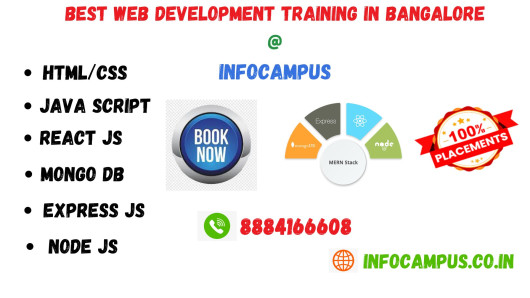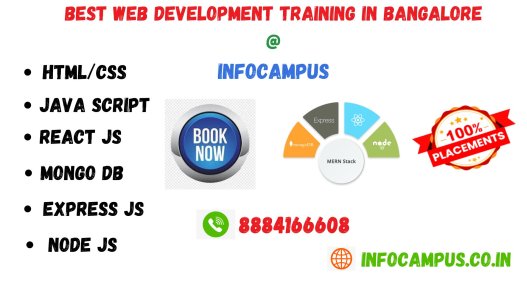In today's digital age, web development is a crucial skill set, and mastering full stack web development opens up a world of opportunities. Whether you're aiming to become a professional developer or looking to enhance your existing skills, a structured course can provide the foundation you need. This article outlines what a full stack web development course typically covers, why it's valuable, and what to look for in a comprehensive program.
Why Learn Full Stack Web Development?
Full stack web development involves both front-end and back-end development, giving you the ability to create fully functional web applications from start to finish. Here are some compelling reasons to pursue this field:
1. Flexibility: You can handle any facet of a web project, from database and server management to user interface design.
2. In-demand Skills: Companies seek developers who can handle the entire development process, making full stack developers highly desirable.
3. Entrepreneurial Opportunities: Knowing both front-end and back-end allows you to build your own projects and startups.
What Is Covered in a Full Stack Web Development Course?
A comprehensive full stack web development course typically includes the following components:
Front-End Development:
Web page structure and styling are built using HTML and CSS.
• JavaScript/TypeScript: Programming language for dynamic interactions on web pages.
• Front-End Frameworks: Such as React, Angular, or Vue.js for building interactive user interfaces.
Back-End Development:
• Server-side Languages: Like Node.js (JavaScript), Python, Ruby, or PHP.
• Databases: MySQL, PostgreSQL, MongoDB, etc., for storing and managing data.
• Server Management: Understanding server architecture, deployment, and handling server-side operations.
Full Stack Integration:
• RESTful APIs: Creating APIs to communicate between front-end and back-end.
• Version Control Systems: Using Git for collaborative development and version control.
• Security Practices: Implementing authentication and authorization methods.
Additional Skills:
• DevOps Basics: Understanding deployment processes and containerization (e.g., Docker) .
• Testing and Debugging: Writing tests and debugging code for robust applications.
• Continuous Integration/Continuous Deployment (CI/CD): Automating deployment pipelines.
Choosing the Right Course.
When selecting a full stack web development course, consider the following factors:
1. Curriculum: Ensure it covers both front-end and back-end technologies comprehensively.
2. Projects: Look for courses that offer hands-on projects to apply what you learn.
3. Instructors: Experienced instructors with industry backgrounds can provide valuable insights.
4. Flexibility: Determine whether the course is suitable for your learning style (online vs. in-person, self-paced vs. structured) .
5. Reviews and Recommendations: Seek feedback from past students to gauge the course's effectiveness.
1. Versatility and Full Control:
• End-to-End Development: Full stack developers can handle both front-end and back-end development tasks. This means they have complete control over the entire development process, from designing user interfaces to managing databases and server-side logic.
• Problem Solving: They can troubleshoot issues across the stack, leading to faster problem resolution and smoother project workflows.
2. Career Opportunities and Market Demand:
• High Demand: Companies increasingly prefer full stack developers who can contribute to all aspects of a project, reducing the need for multiple specialized roles.
• Versatility in Roles: Full stack developers can work in various roles from startups to large enterprises, across different industries, making their skills highly adaptable and in-demand.
3. Efficiency and Cost-Effectiveness:
• One Developer for the Entire Project: Employing a full stack developer can be less expensive than paying front-end and back-end engineers separately. This is especially beneficial for smaller teams or startups with limited resources.
• Faster Development Cycles: With knowledge of both ends of the stack, developers can streamline development processes, iterate more quickly, and deliver projects faster.
4. Improved Collaboration and Communication:
• Cross-Functional Teams: Full stack developers can bridge the gap between front-end and back-end teams, fostering better collaboration and communication within development teams.
• Understanding Different Perspectives: They have insights into how both sides of the application interact, leading to more cohesive and integrated development efforts.
5. Adaptability to Technology Trends:
• Tech Stack Flexibility: Full stack developers are versatile with technology stacks. They can adapt to new frameworks, languages, and tools as technology evolves, ensuring they stay relevant in a dynamic industry.
• Innovation and Experimentation: They can experiment with new technologies more easily, integrating innovative features and functionalities into web applications.
6. Entrepreneurial Advantage:
• Building MVPs (Minimum Viable Products): Full stack developers are well-suited for developing prototypes and MVPs quickly. This ability is crucial for startups looking to validate ideas and attract early adopters.
• Solo Projects and Freelancing: They can work independently on projects, from ideation to deployment, offering flexibility and autonomy in their work.
7. Holistic Understanding of Development Lifecycle:
• User Experience Focus: Full stack developers understand the entire user journey, which helps in designing intuitive and user-friendly interfaces that seamlessly integrate with the back-end functionalities.
• Maintenance and Updates: They can handle ongoing maintenance, updates, and scalability of applications, ensuring long-term success and user satisfaction.
Conclusion:
Mastering full stack web development is a rewarding journey that equips you with versatile skills in high demand across industries. Whether you're starting from scratch or enhancing your existing knowledge, a well-structured course can provide the guidance and practical experience needed to succeed. By choosing the right course and dedicating yourself to learning, you can build a solid foundation for a fulfilling career in web development.
Get industry-ready web development skills at Infocampus. Our hands-on training program in Bangalore will teach you the latest technologies to build modern, responsive websites. Enroll now and kickstart your career as a web developer. Enroll now to kickstart your tech career. Limited seats available, don't miss out! For more details Call: 8884166608 or 9740557058
Visit: https://infocampus.co.in/web-development-training-in-bangalore.html


















